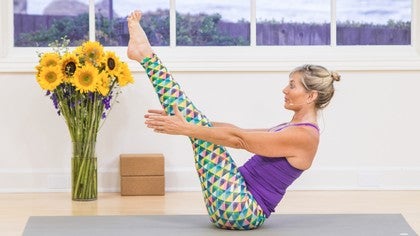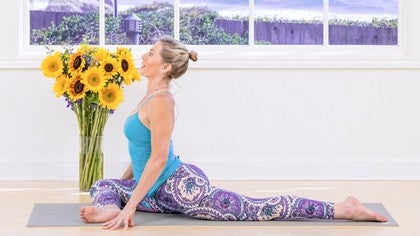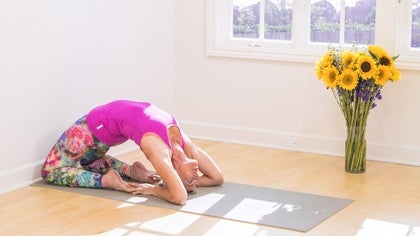Description
About This Video
Transcript
Read Full Transcript
(wave crashes) Namaste. There's no question that I use my practice on the mat to develop gumption, because I've found that I need gumption, and I think we probably all need gumption. What I know for sure, is that if I were to rely on this thing to dictate what I'm capable of or what is possible, I would end up living in a very small box, and I use my practice to step back and watch what this thing says, and in the process, I'm working to make the whole body strong, and you've probably heard that there's some brain cells down here in the gut, and I love the fact that they're down there, because I like the idea that if I dig a little deeper, I'm probably going to find the answer to whatever it is, the issue at hand, happens to be, and these postures are designed to help us cultivate our inner resources to dig a little bit deeper. Okay, you ready? Here we go.
If you happen to have two blocks at home, I know that not everybody does have two blocks at home, please get them, and if not, no worries, you can use one block. I'll show you how to use just one block, and no blocks is also fine, but you can imagine that you have a block and that will help you immensely. With two blocks, they'll be on either side of you, pretty much positioned underneath the shoulders. If you have one block, it's going to go between the thighs, and you're going to squeeze that block with your hands down on the floor, and if you have no blocks, you're going to pretend that you have two blocks here, and one block between your thighs, okay? This just gives you a chance to feel as though you're lifting higher than you actually are, but that's really fun, and the block between the thighs is critical, because what happens in the body, especially as we get older, is this inner line, it weakens, and if we keep this inner line strong, we're able to have really good posture, hold ourselves upright, rely on inner resources, so we want to squeeze in and lift from the inside.
The hands come underneath. We're moving towards Lolasana, and this is what it looks like. I like to bring my belly all the way down, and I make a pact with myself that I will not let my thighs lift off my belly. Okay? My elbows are back behind me.
My arms are in close. I'm on the front of my feet, and when I lift up, I come right up onto the toes. Now, I've straightened the arms. This is the tricky part. I'm going to float here.
I'm going to attempt to keep the legs in super close and lift everything. Mushroom the upper back, and then come down when you're finished. Now I know that what that might have looked like for you was what it looked like for me for a long time, which was, nothing happened when I lifted. What counts here is jumping. You can jump the legs up.
Jump up. Jump up, and then get the idea of hovering and staying in the air as long as you can. Okay? From this posture, this posture's the foundation for all of the postures that will follow it, this lift from the inside, the pelvic floor lifts, the navel draws back to the spine, and we'll investigate this action from a variety of perspectives. Okay?
Let's pause for a moment, close the eyes, bring the hands to the heart, and we'll open our practice. Namaste. Removing the blocks, if you had blocks, let's come back to the top of the mat, and we're going to be up on our feet, and we'll come deeply into Malasana, squat. I like to just move back and forth here a little bit to get into the hips, but we remember Lolasana as we approach Crow, really Crane pose. If you are new to this, you're going to bend the elbows a little bit, zip up your inner line like we just did in Lola.
Place the legs on the arms, zip up, look forward, that's the most important part so you don't fall on your head. You've probably heard having a blanket out here just in case, is good. Somehow, when we're learning this posture, we like to look at our own body while we're doing it, which is not a good idea. You want to look forward. Come up, and try this first.
If you can bring the feet off, the toes touch. Hollow out. Hollow out everything, and then come right back in to Malasana. Now let's say you've been playing with Crow, and you want to take this a little bit further. The next step is fingers spread wide apart.
You're going to come up, and you're going to line up your arms so that they are as straight as possible. You're going to draw your navel into your spine and bring your thighs back to your ribs, and make a pact again that they stay together. You're going to look forward, and one foot may be first, and then the other foot. Straighten and hollow out the middle of the body. Then back down, and let's pause for a moment just to release the wrists, and then go the other way.
You keep the wrists together the whole time. Good, and then let's just erase that. Bring your hands to the floor, legs back, lower through. Inhale open. Exhale, navel to spine, back to Downward Facing Dog.
Three breaths. Wake up the whole body. It's not a lot of effort. Just want to be sure attention throughout the body, like the whole body has eyes. Good, bend your knees.
Look past your hands. You can slowly come down to a seat, and send your legs forward. Okay, Dandasana, wonderful posture. You may find that your back rounds, in which case, knees bent. You want your back to feel just like Tadasana, Mountain Pose, vertical spine.
Root your sit bones. Kneecaps lift, toes wide. Notice what's got to go on in here to help support being upright. I know for my practice for many years, I didn't understand the inside. I'd just get the limbs in the right place, but the inside really wasn't, nothing was happening.
It may not look like much is happening here, but wake up the inside like you've got a little fire burning inside you. Okay, from here, we'll take the easier variation first. Bend the knees. Take your hands back behind you. Curl the tailbone up.
Good. Then draw your shoulder blades together. Take a look at your navel. Draw it in. Press upward.
Release the head back if there's no pressure on the neck, and if you wish, both legs will go long. Purvottanasana, bring the big toes to the floor. Lengthen the whole back side. Inhale here. Exhaling.
Down we come. Grasp the knees. Walk the legs in a little bit. Give yourself a hug first, and float on your sit bones. This is another one where it's very easy for the navel to just soften and relax, but we need it.
Draw the navel to the spine. Toes go wide. Shoulders down. Hands to the back of the thighs. Legs, shins come up.
You can stop anywhere along the way. Feel your back, it's long. Draw the navel in further. Legs could extend. Arms can extend.
I like feeling as though my shoulder blades are supporting my heart. Now, peace fingers. Grasp big toes. You may need to bend your knees to get hold of them, and then go wide, and come really far forward on the sit bones, and drop your shoulder blades down deeply and lift your heart. Lots of space, push though the balls of your feet.
Notice the breath is going top chest, and then slowly, slowly the legs come back up. We take hold of the back of the legs. Widen the toes. Good. Pretend your body is a tree, and you're climbing up your legs.
You're drawing the legs to the face, the face to the legs. If you've got room to wrap your elbows around your legs, do. Push into the ceiling. Look up at the big toes. Face draws to shins.
The game we're playing here is, how long can the spine be. That's why the navel is so necessary. Draw your navel into your spine. Good. Release.
Pause for a moment. Remember I said, it should feel like you've got a fire burning in your belly? At this point you probably can feel that. Let's cross the ankles. Hands to the floor.
Float the legs back. Lower through. Inhale, lengthen the front spine. Exhale back. Downward Dog.
Root the legs, and come down for a moment, sitting in our good friend Vajrasana. We'll move on now to a lovely prep pose, and this is a posture that's been around for a long, long time. There's very early depictions of this posture. I think that it was a posture mostly for men, but I think that the challenge for women is really good. It has a superior function of being really good for the digestive system.
That's our main objective, and then we can play with it and see where we can go. Mayurasana. First, let's take the hands to the floor. This is a big deal. The fingers go wide.
Some of you will find that to get the palms all the way down is really challenging. We're just lengthening the front, the inner arms, and what I'm going to do, is I'm going to scoop the shoulders back. It's very easy to get vulture like here, so I'm going to pull back. That's the first thing I got to see, is do I have the space along the arms? That may be the work.
Now, the navel's got to draw in to the spine. I want to keep my hands pretty close together, because when I bend my elbows, I want my forearms to still be connected, like it's just one leg I'm working on. Now, what's going to happen here is I'm going to exhale through the nose and bringing my elbows as low down my belly as possible, right above the pubic bone. Inhale, come back up. That was a big old deal.
For many people, that is a huge challenge. We exhale, elbows right above pubic bone. Okay, back. I know that you might have bigger breasts than I have, and breasts and this pose don't necessarily get along. You're going to have to work it out around the breasts, but there's a next step, and this is what it looks like.
We'll exhale, and what I suggest you do is take your legs really wide. Now, send your chest forward. Navel's in. Finger tips on the ground. I'm going to play with, will the legs lift off?
Now, can I send the chest forward? Can I reach, reach, reach, back through the legs? Now, you've got to play with that. Oh my gosh. Okay, back down.
Pause for a moment. That's really challenging, right? If you have your block, go ahead, place you block right back behind you, and to help you work on this pose, because it can take some time to get into, put the feet, tuck your toes under, put your feet on the block, and then back again. Fingers in, navel in. Dive.
Chest forward. Legs off, straighten. Chest, chest, chest, come forward, forward, forward. Come onto the toes. Yes, and see if you can lift the feet off, and work on it, and come back.
Pause. Grasp your knees. Pull just to release the wrists, and roll. Roll the wrists again. What I've found in this practice is I have postures that I just love, and then there's postures that really challenge me, and it's very easy to avoid those.
When I get challenged, we're all different, sometimes people tend to just withdraw when they're challenged. I tend to get pissed off and then withdraw. (laughs) Roar and then withdraw, but I want to watch that. What do I do when I'm faced with the challenge, because I'm doing that when I'm not on the mat. Whatever that thing is I'm doing, I'm doing it elsewhere in my life, and what I've found is that those poses that are the most worthwhile for me, are the ones I've really had to work at and stay with over time.
We all know some things come easy, but what happens then is we go down those easy roads, and eventually we wear out the options. We know that. We know that road, so find three to five postures that, rawr, challenge you, and do them. Do them regularly. All right, next, another posture that may challenge you.
This one could be done with a block. I'm not going to do it with a block given where I'm going to go with it, but turn the palms up. Just make fists here in case the wrists still need a little attention. My navel starts to draw into the spine. I put my hands down, fingers spread wide, palms down.
If you're new to this posture, what happens here is people will go like this, they will roll their fingers, the index pads off the mat. Don't do that. You're going for forearms as parallel as possible to one another. If the elbows are out, no worries. In time that will work itself out.
Now navel brings me up to Dolphin. In Dolphin, we're attempting to draw the outside of the heels down to the ground, but that likely will not be the case. You can play with drawing the feet in. See how far forward they'll come. Then back a little bit.
See if you can draw the heels down. Now, remember the navel. You remember boat pose? This is essentially boat pose, right? Upside down.
You're looking at your thumbs, wrapping your shoulder blades around your upper torso. You might take right foot to midline. Lift the left leg up. Reach up through the left foot, and that action starts at the navel. Right foot goes up.
Reach up. You want to work on getting light through the feet. Come down. Rest for a moment. Child's Pose.
Just notice how much that posture asks from you. Good, let's try one more time. Some of these postures are really best done several times, because each time we do them, they open just a little bit more, or we open just a little bit more. Up we go. Look forward at your thumbs.
Left leg can come up. Play with, oh, will the bottom foot come off? Wake up the toes. Draw the navel into the spine. If you have the left leg raised, just lower it.
Come back down. Go right back up. Right leg might go up. Same thing, navel to spine. You can play with this side.
Inner thighs still drawing toward each other, and back down. Good. Slowly come up. We'll just come to a seat, comfortable seat, same idea, Mountain. I always just take a moment to appreciate.
It often happens spontaneously, "Wow, my body moved that way." Whatever way it was, I've got this body, this vehicle, that I can express my intention through, and over time and with practice, I'm able to find things inside myself I didn't know were there. As we transition now into a seated meditation, lengthen the front line, zip up. Create a little space in the back of the neck. Become aware of your spine, from the sit bones, all the way up the spine, and actually up and around the top of the head, the skull, and down the face, as if the direction was headed right toward the heart, or the center of your body. I've lived a little while, and what I've learned in that time is that answers do arrive, usually not on my own time schedule, and that if I live in a very open state, using the practice to release all of my ideas about the way that it is or the way people are, and I turn my attention inward to the great question, like I'm looking inside to this very open landscape, something inside me will grow.
The truth, whatever the truth is, as it arises, I'm there to pay attention to it, and I begin to, over time, know the difference between truth and a lot of ideas I've got about the way things are, and the truth really resides throughout my whole body, less based in the frontal lobe, but it requires patience and dedication and constant inquiry, and that's what we're doing here in yoga. We move our body. We learn about all the stuff that comes up when we do that, and we keep digging in a little deeper, kindly, attentively, with discipline, open. Now let's draw the palms together at the heart, and we'll close our practice as we always do. We bring the hands to the forehead.
Right thought, may we be steady and present and joyful. The hands come to the mouth, speech, may our words improve upon the silence, and our hands come to our heart, action, may we be the change that we wish to see. Namaste.
Mandala Yoga
Comments
You need to be a subscriber to post a comment.
Please Log In or Create an Account to start your free trial.

















